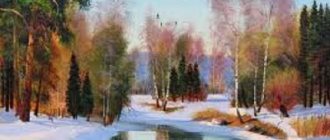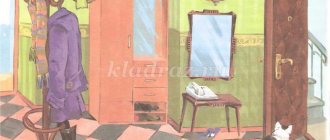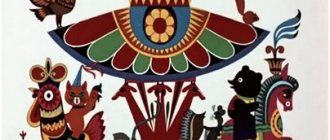Visiting the stars
It’s great if, while relaxing in the village with your grandparents, you and your child devote several evenings to stargazing. It's no secret that it is in the distance from city lighting that the sky appears before us in all its glory, striking us with a myriad of stars. Searching for certain constellations in the sky is an exciting and useful activity. And it’s okay if your child breaks out of his usual routine and goes to bed a little later. But he will develop observation and memory, abstract thinking and imagination, and learn a lot of new and interesting things. If you yourself are not very good at navigating the constellations, it doesn’t matter. Almost all children's books on astronomy have a star map. Carefully look at this or that constellation with your child, and then compete to see who can find it in the sky faster. This is not an easy task.
Many constellations have had their names since time immemorial. Ancient people peered into the night sky, mentally connected the stars with lines and imagined various animals, objects, people, and mythological heroes. Different peoples could have different names for the same constellation. Everything depended on what people’s imagination told them. Thus, the well-known Ursa Major was depicted both as a ladle and as a horse on a leash. Amazing legends are associated with many constellations. It would be great if you read some of them in advance, and then retell them to your child, peering with him at the luminous points and trying to see the legendary creatures. The ancient Greeks, for example, had a legend about the constellations Ursa Major and Ursa Minor. The almighty god Zeus decided to marry the beautiful nymph Calisto, one of the servants of the goddess Aphrodite. Aphrodite wanted to stop this. And then Zeus turned Kalisto into Ursa Major, and her beloved dog into Ursa Minor and took them to heaven.
Try to find the Milky Way in the sky. It is clearly visible to the naked eye. Tell your child that the Milky Way (which is the name of our galaxy) is a large cluster of stars that looks like a luminous strip of white dots in the sky and resembles a path made of milk. The ancient Romans attributed the origin of the Milky Way to the sky goddess Juno. When she was breastfeeding Hercules, a few drops of breast milk fell and turned into stars, forming the Milky Way in the sky...
Encyclopedia for the curious “Why and Why”. Translation from English by T. Pokidaeva
This book has a section on time and seasons. Important concepts are explained clearly and in accessible words. The book is intended for reading by adults to children, it can be used for preschoolers.
Why does the sun rise and set? Why is it dark at night? What is a leap year and why do we need a calendar? What time is it in space?
The great advantages are high-quality illustrations, good paper and binding.
Astronomers
How tempting it is to become an astronomer, intimately familiar with the Universe!
It wouldn't be bad at all: Observing the orbit of Saturn, Admiring the constellation Lyra, Detecting black holes. And be sure to compose a treatise - “Explore the depths of the Universe!”
T. Sobakin
Astronomers are scientists who observe and study stars.
In those distant times, when people did not yet know how to read and write, they watched with amazement what was happening in the sky. It seemed to them that the sky was a crystal cap that covered the Earth, and the stars were attached to the sky for decoration.
Ancient people thought that the Earth was stationary, and the Sun, Moon and stars revolved around the Earth.
Many years later, astronomer Nicolaus Copernicus proved that the Earth and other planets revolve around the Sun.
Another scientist, Newton, understood why the planets revolve around the Sun and do not fall; they are mutually attracted to each other and do not allow each other to move away from themselves or closer to themselves. Therefore, they all fly around the Sun, each on their own path.
Thus, scientists gradually discovered the secrets of space.
Ancient astronomers studied the stars without special instruments, observing the sky from Earth. In the Middle Ages, scientists invented the spyglass and telescope to view distant stars. Nowadays, artificial satellites and space stations fly in space, exploring planets and stars.
The Universe still has many mysteries, and astronomers will have enough work to do for a long time.
Day and night.
An inquisitive child will sooner or later wonder: why is there day and night? And in order not to explain the structure of the world with fingers, let’s try to create a model of the rotation of the Earth around its axis and the Sun. To do this, we will need a globe and some kind of light source, such as a candle or table lamp. Tell your child that nothing stands still in the Universe. Planets and stars move along their own strictly defined path. Our Earth rotates around its axis and this is easy to demonstrate with the help of a globe. On the side of the globe that faces the Sun (in our case, the lamp) there is day, on the opposite side it is night. The earth's axis is not straight, but tilted at an angle (this is also clearly visible on the globe). That is why there is a polar day and a polar night. Let the child see for himself that no matter how he rotates the globe, one of the poles will always be illuminated, while the other, on the contrary, will be darkened. Tell him about the features of the polar day and night and how people live in the Arctic Circle.
Great Children's Encyclopedia Translation from English by T. Pokidaeva
Any quick question from a child’s lips will not sound scary, because this encyclopedia has everything to answer what the Universe and the Milky Way are, how many stars are in the sky and why they twinkle, which stars can explode and whether the Sun will die. Part of the book is dedicated to space.
The book is not overloaded with texts that are difficult for a child to understand; the illustrations are bright and clearly demonstrate phenomena that can be difficult to explain in accessible language.
“A Tale of Happiness” from skazzzki.ru
You can order an interesting personalized fairy tale for your child through the skazzzki.ru service.
“The Tale of Happiness” is a personalized (the name of the child and parents are personalized) adventure book for children from 5 to 11 years old. A modern fairy tale for fans of fantasy and adventure, the main character will be transported to a distant planet ruled by real bandits. The main character, driven by ambition and a keen sense of justice, comes to the defense of the oppressed people and leads the uprising. The book has beautiful modern illustrations and many memorable characters.
Who invented summer?
Let's look at our model again. Now we will move the globe around the “sun” and observe what happens to the lighting. Due to the fact that the sun illuminates the surface of the Earth differently, the seasons change. If it is summer in the Northern Hemisphere, then in the Southern Hemisphere, on the contrary, it is winter. Tell us that it takes the Earth a whole year to fly around the Sun. Show your child the place on the globe where you live. You can even stick a little paper man or a photo of a baby there. Move the globe and try with your child to determine what time of year it will be at this point. And do not forget to draw the young astronomer’s attention to the fact that after every half revolution of the Earth around the Sun, polar day and night change places.
Mysterious moon
Children look at the Moon in the sky with delight. This Earth satellite can become an interesting object of study. After all, the Moon is so different and constantly changes from a barely noticeable “sickle” to a round bright beauty. To explain to the child the reason for these changes, let us again turn to our model with a globe. Only now a small ball – “Moon” – will be added to it. Show your young astronomer how the Moon revolves around the Earth and what happens to the lighting. Explain what a new moon, full moon, waxing and waning moon are.
To better understand and remember the phases of the Moon, keep an observation diary with your child, where every day you will sketch the Moon as it appears in the sky.
If on some days clouds interfere with your observations, it doesn’t matter. Still, such a diary will be an excellent visual aid.
Of course, the child will be interested to know what is on the Moon. Tell him that the surface of the Moon is covered with crater craters caused by collisions with asteroids. If you look at the Moon through binoculars, you can see unevenness in its relief and even craters. Try this experiment. Place a mound of flour in a cup or plate. Now throw a plasticine ball there. Carefully remove the ball and get something like a crater. The Moon has no atmosphere, so it is not protected from asteroids. But the Earth is protected. If a stone fragment enters its atmosphere, it immediately burns up. Although sometimes asteroids are so large that they still manage to reach the surface of the Earth. Such asteroids are called meteorites.
What did the telescope reveal?
You can start getting acquainted with the world of stars and planets by visiting the planetarium. The picture of the starry sky presented there is very clear and will help the child better understand what you are talking about. Typically, planetariums have programs accessible to the youngest astronomers. Choose topics that interest your child most at the moment. Maybe it's spaceships and space exploration? Or who are aliens and what can you see through a telescope? Or maybe the baby loves fairy tales and wants to learn about the country of Sunny Bunnies or go with the baby mammoth in search of his mother? There is sure to be something interesting for every young astronomer. And don’t forget to discuss what you saw with your son or daughter, together find answers to your questions and draw what you remember most...
The space theme contains a lot of ideas for drawings, crafts made from paper, cardboard, and plasticine. You can draw fantastic alien worlds and spaceships, sculpt space aliens, model the Martian or lunar surface from plasticine, come up with new names for planets and constellations, and invent your own galaxies. This topic is limitless and magnificent because it provides food for children’s imagination, develops innovative thinking, stimulates cognitive interest and the desire to constantly learn something new.
Efrem Levitan “To kids about stars and planets” (“Rosman”)
mamsila.ru
This book is a bestseller that has collected a huge number of rave reviews; its author is Efim Devitan, a famous popularizer of astronomy. Perfect for children aged 4 years and older to explore space for the first time.
This astronomical tale tells kids about the Universe in an accessible and fun way. Visual illustrations and simple experiments help parents explain complex phenomena using simple examples.







